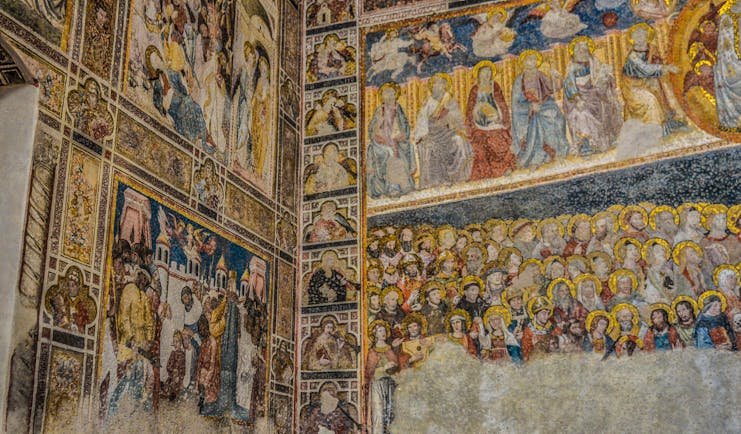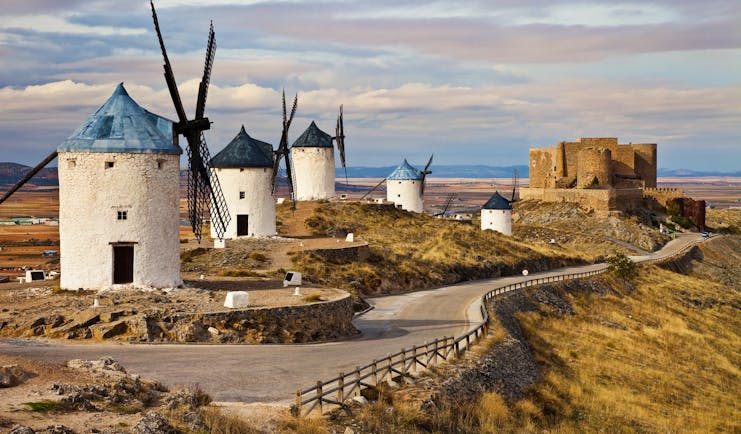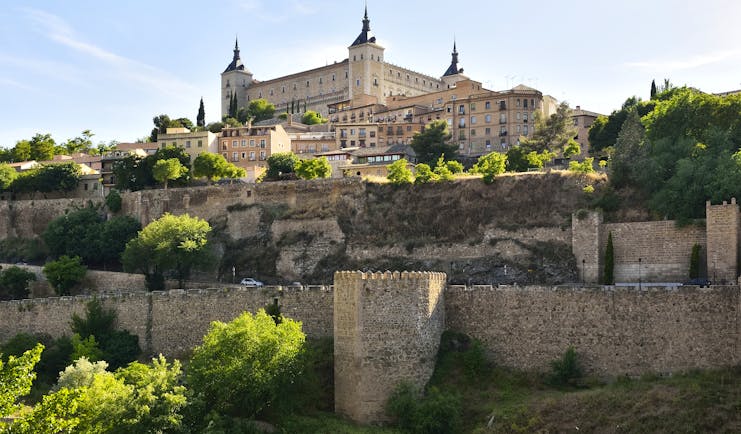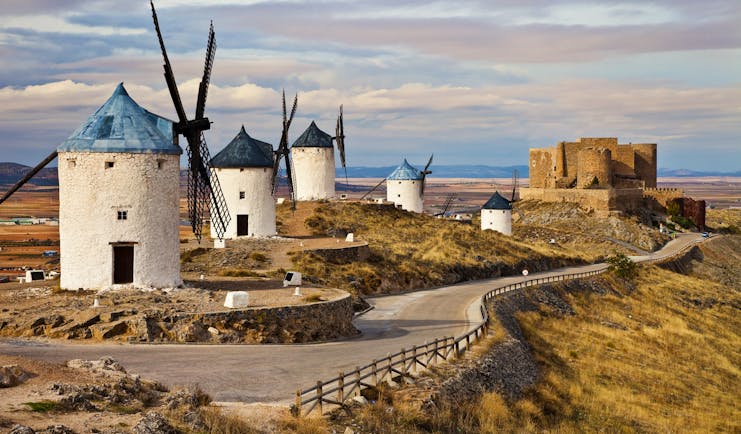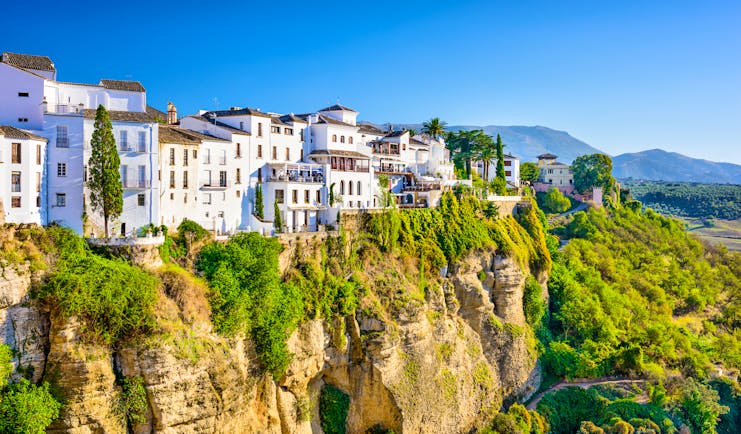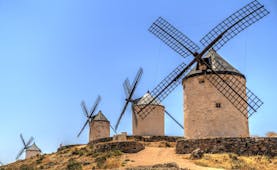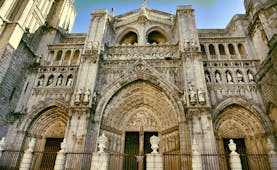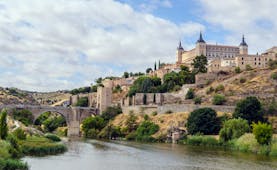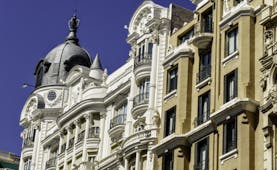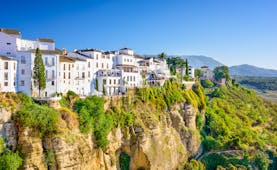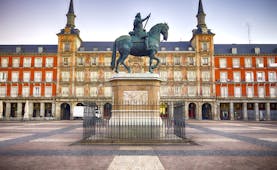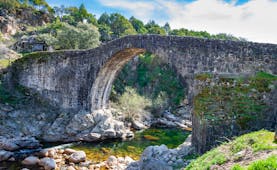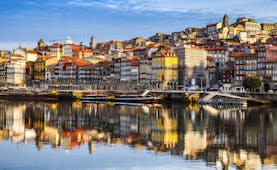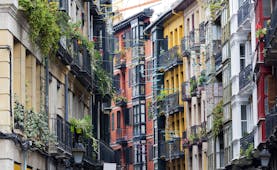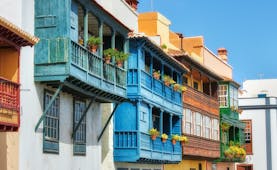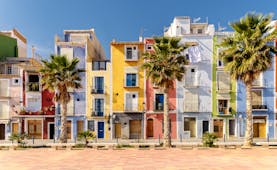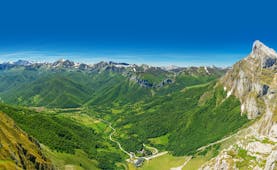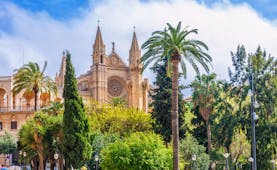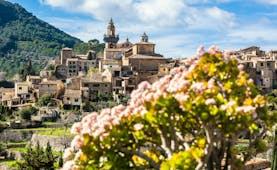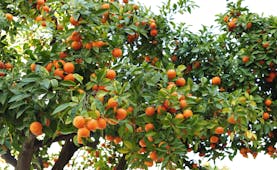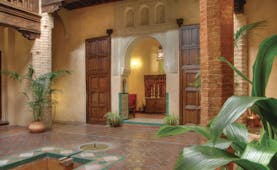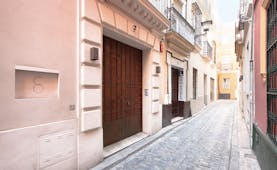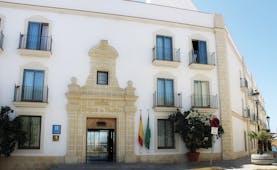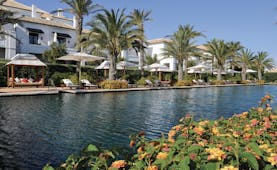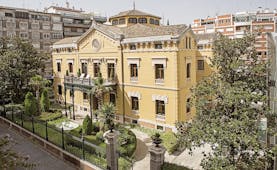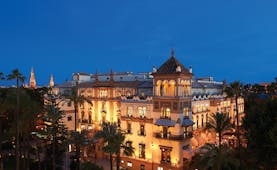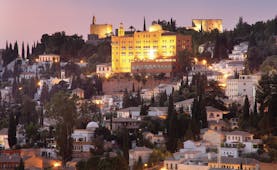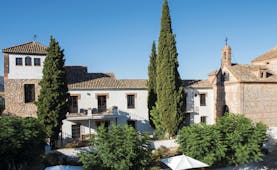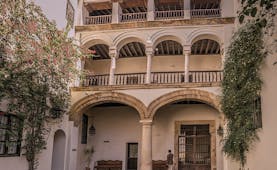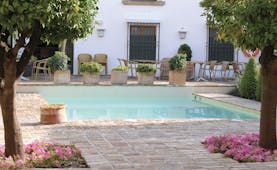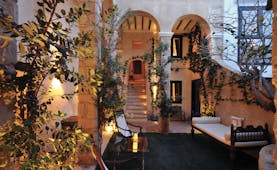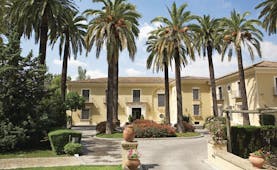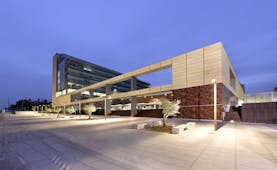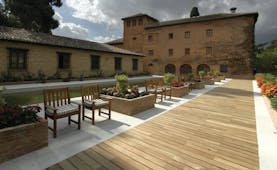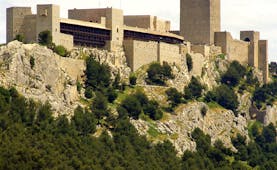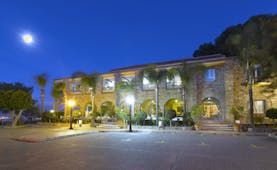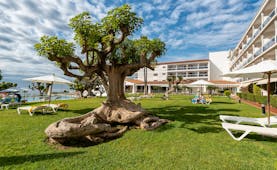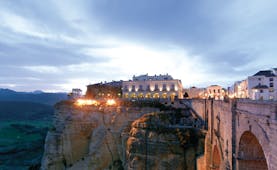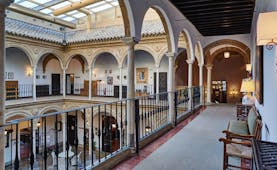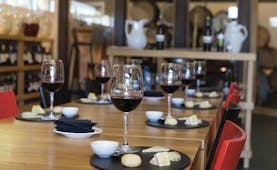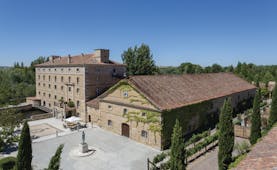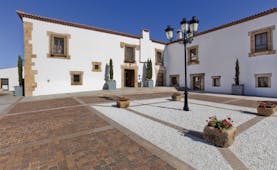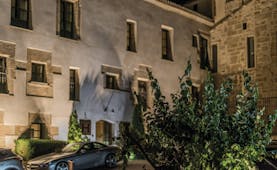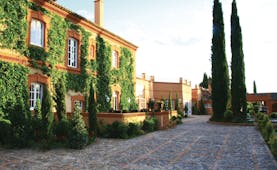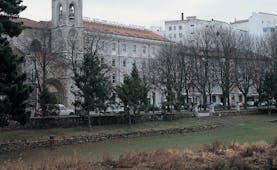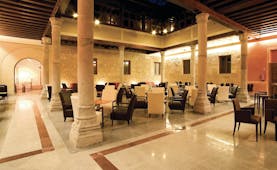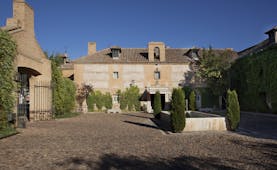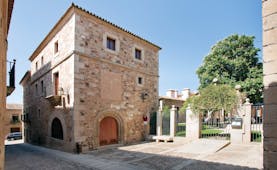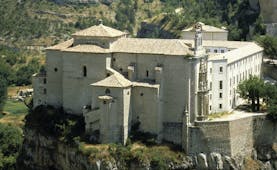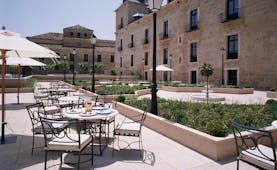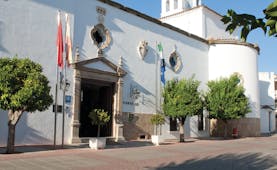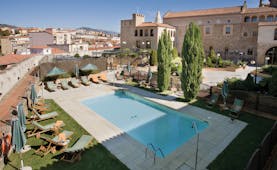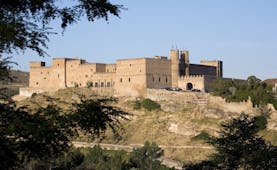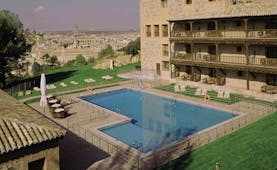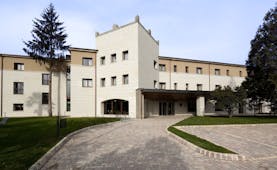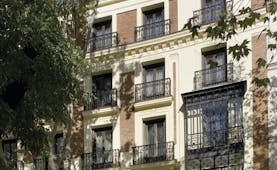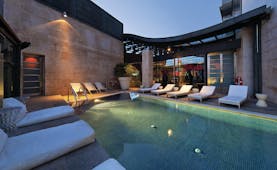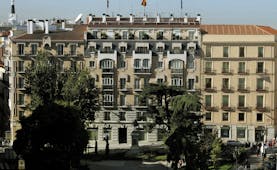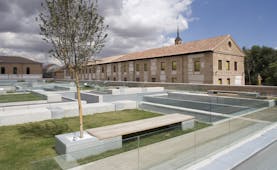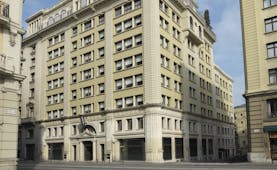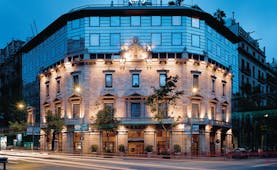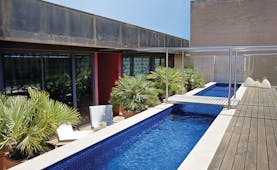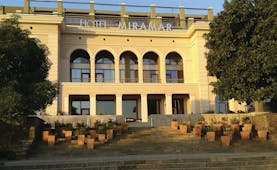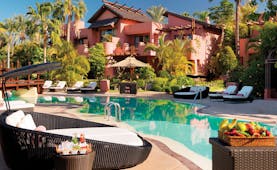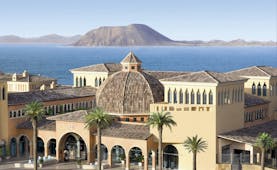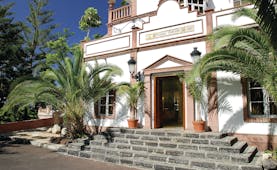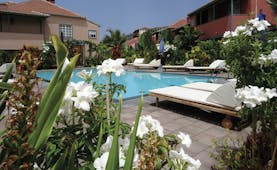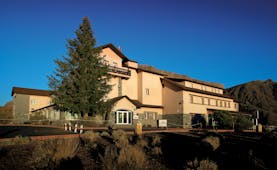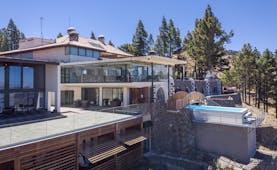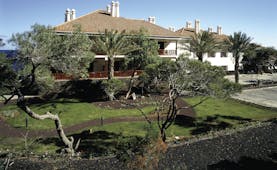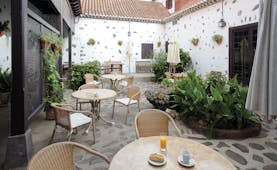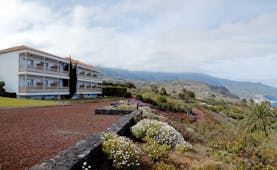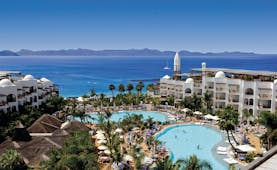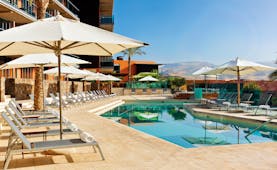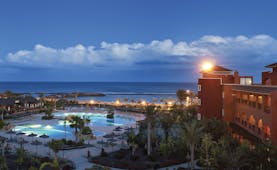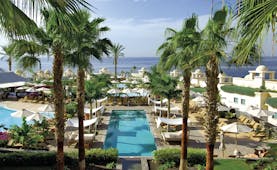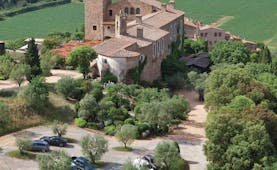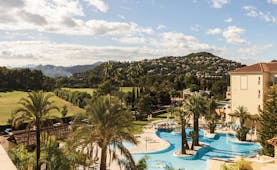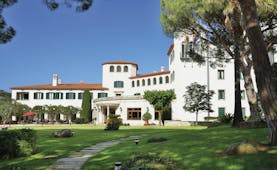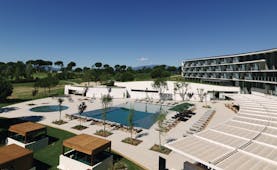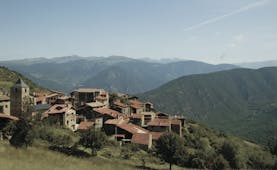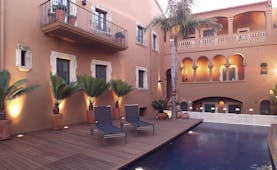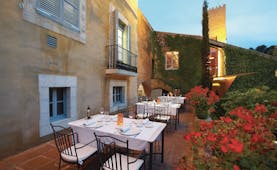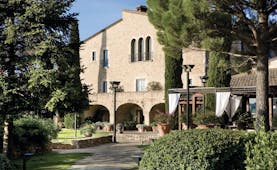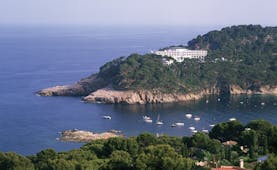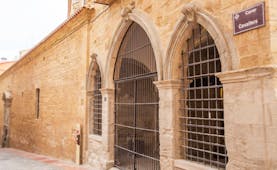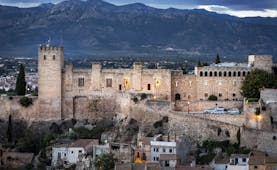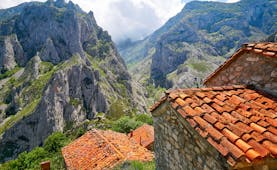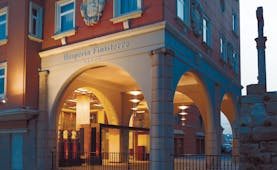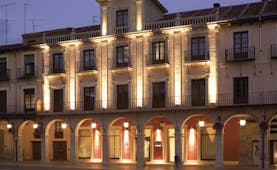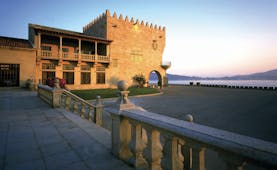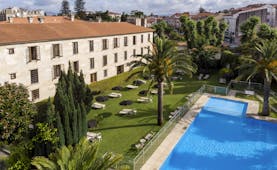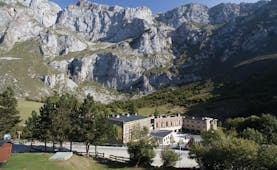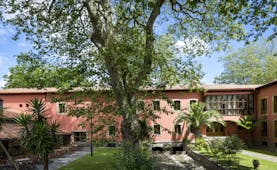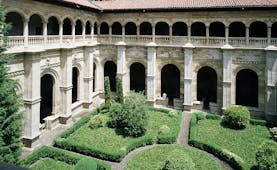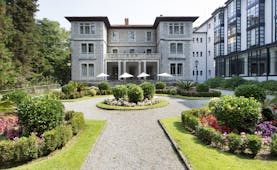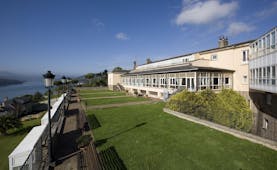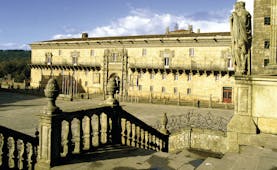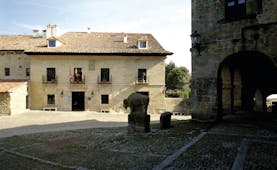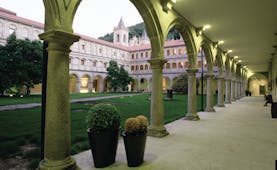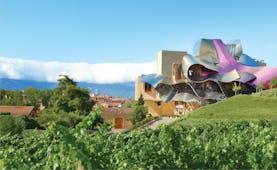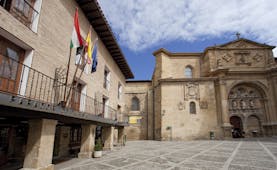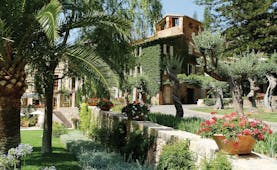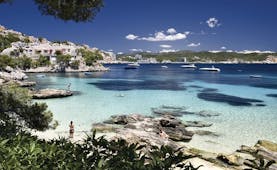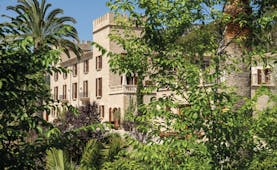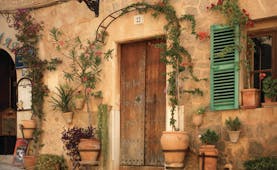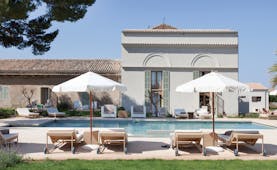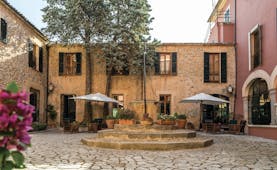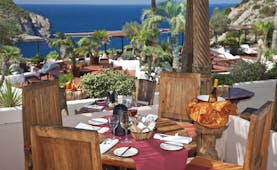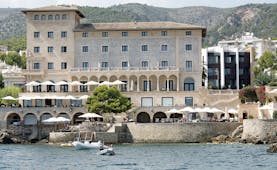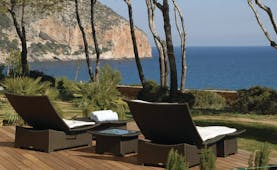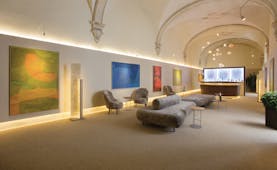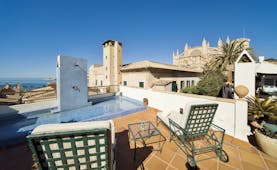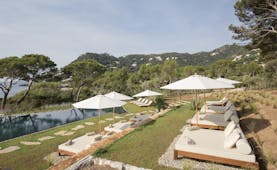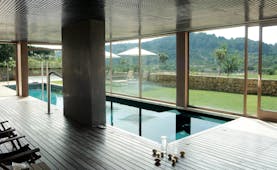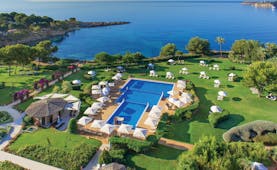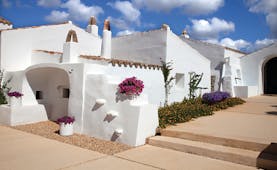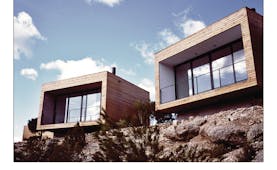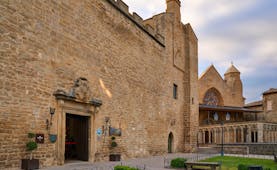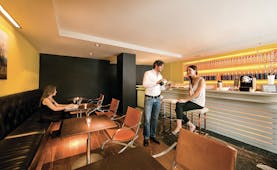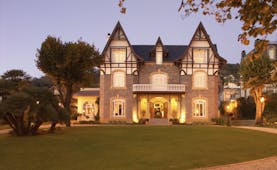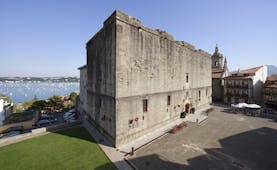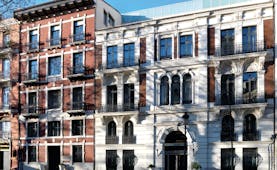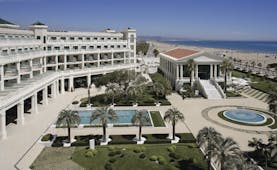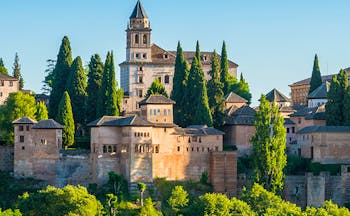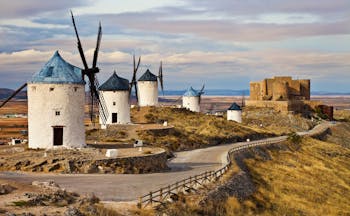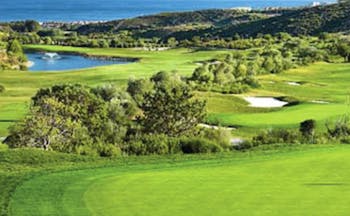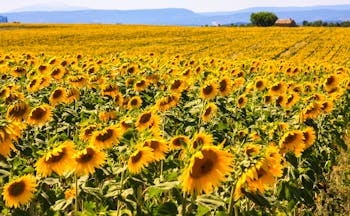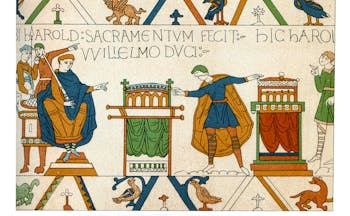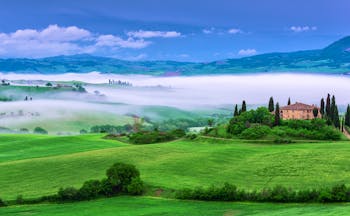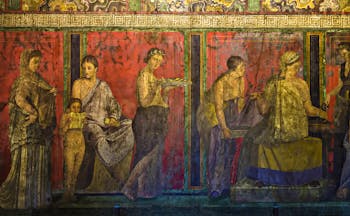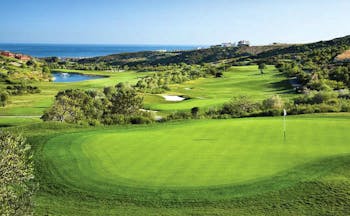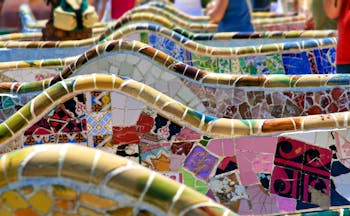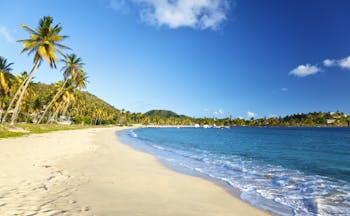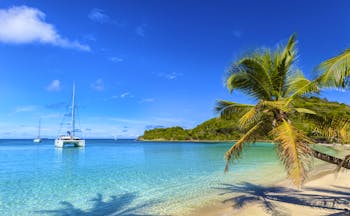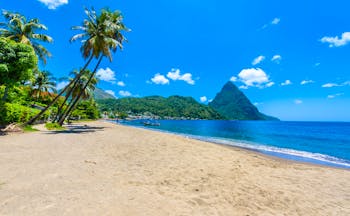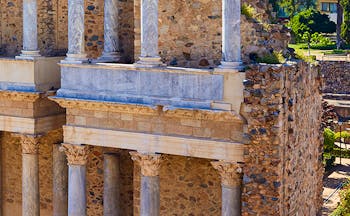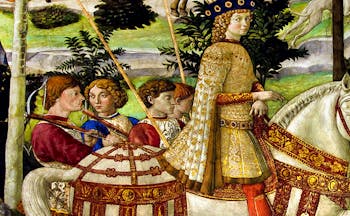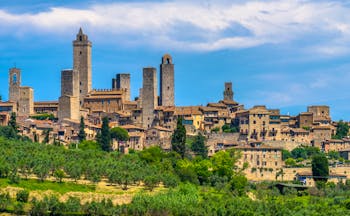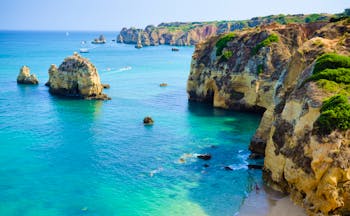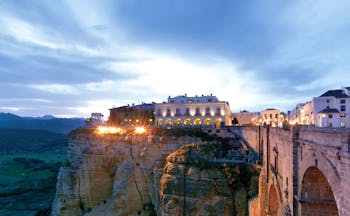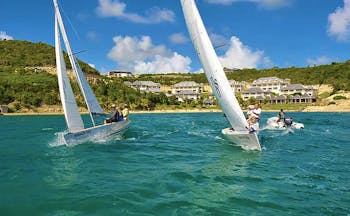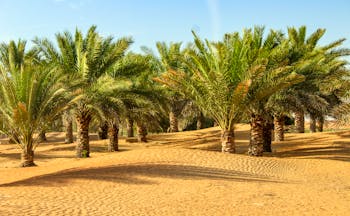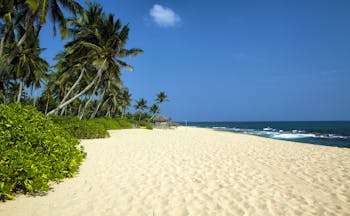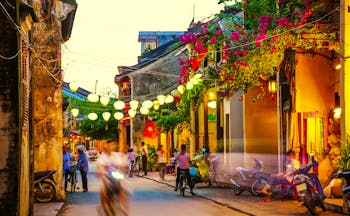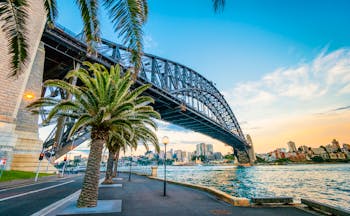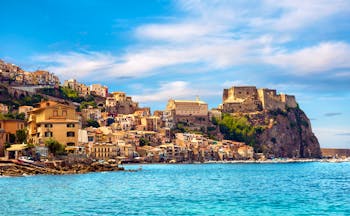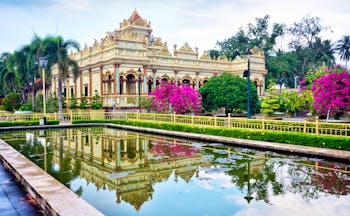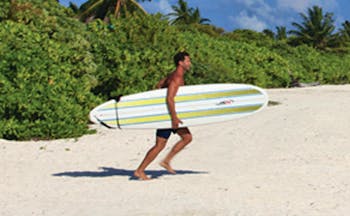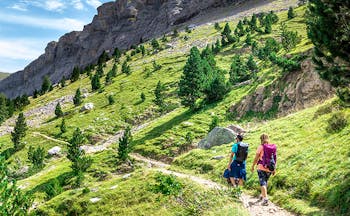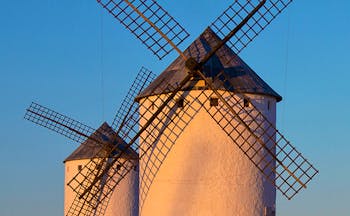Luxury fly-drive touring holiday from Madrid to Toledo and Andalusia staying in Baeza, Cordoba and Ronda
This 7-night luxury fly-drive touring holiday takes you from Spain’s capital city, Madrid, at the heart of the country, southwards towards the Mediterranean coast. As you progress south you’ll witness the authentic history and scenery of inland Spain. This is the real Spain and a Spain with thousands of years of history where the traditions, cultures and religions of Moors, Jews and Christians blend. From Madrid to make your way with your hire-car to Toledo, the country’s former capital. This picturesque city is built into a dramatic meander of the Tagus River, which stretches across the centre of Spain. Enjoy the stunning green views across the countryside and the rising spires and domes of Toledo, the City of Three Cultures. Then, continue your journey south to Baeza, stopping off at the famous windmills of Consuegra, which feature in Cervantes’ ‘Don Quixote’, and then at the vineyards and bodegas of Valdepeñas, one of Spain’s most renowned wine regions. Spend two nights in the culturally-diverse city of Baeza, and exploring the delights of the surrounding olive groves, vineyards, and countryside including the nearby city of Ubeda. Baeza contains a wealth of contrasting and beautiful architecture. From Baeza you drive to the city of Cordoba where Arab and Jewish influences blend. Your final stop is further south still, in the hinterland of the of Costa Blanca, where you stay in Ronda, one of the best-known and prettiest ‘pueblos blancos’. You return your hire-car to Malaga where you take your flight home. You may want to add a night or two in Madrid at the beginning of the tour.
Highlights
Toledo • Iglesia de Santiago del Arrabal in Toledo • Consuegra and La Mancha windmills • Bodegas of Valdepeñas • Olive groves of Jaen • Ubeda • Baeza • Cordoba • Mezquita de Cordoba • Ronda • Pueblos blancos
Day by day
Fly into Madrid, collect your hire car, and drive south to Toledo, Spain’s former capital, for two nights at the Parador de Toledo. This converted monastery is separated from the bustling city by a meander of the Tagus River and its lush, verdant banks. Raised on higher ground, the rooms have excellent views out across the domed skyline of Toledo, and the green agricultural land beyond. Spend a few hours on your first day walking around the eclectic City of Three Cultures, named as such because of its intriguing blend of Christian, Jewish, and Muslim influences.
During your stay, visit the central 13th Century Gothic Santa Iglesia Catedral Primada de Toledo to see the golden altar, ribbed vaulted ceiling, and spectacular stained glass which dates back to the cathedral’s beginnings. Enter through the Puerta de Mollete, the doorway through which food was once given out to the poor, and see the marble tombs in the Capilla de Santiago, the retablo of the New Testament in the Capilla Mayor, and the rich collection of paintings in the Sanctuary. Alternatively, visit the Mezquita del Cristo de la Luz to see its traditionally Arabic keyhole archways and colourful stone. The Iglesia de Santiago del Arrabal is reputedly the most stunning example in the city of the Mudéjar architecture so prevalent in the region, with dark brick curved walls that are indented on all sides. The Santa Iglesia Catedral Primada de Toledo does, however, incorporate many Mudéjar features into its Roman Catholic design. On the outskirts of the city, the remains of the Moorish town walls can be seen in the layered archway and battlements of the Puerta Vieja de Bisagra, while the Iglesia de Santo Tomé harks back to the city’s Moorish influence in its tower, which resembles one of the Minarets of Morocco. To reach your hotel from the city centre, cross the river on either the Puente de Alcantara or the Puente de San Martin, both of which are scenic historic bridges. In the evenings, enjoy the views from your terrace, and then dine in the restaurant on excellent gastronomic food based on the local cuisine and ingredients.
Leave the magnificent hilltop aspect of the Parador de Toledo behind and continue south through the region of Castilla-La Mancha towards the border of Andalusia. Take this opportunity to stop off in Consuegra and Campo de Criptana to see the famous white windmills of Miguel de Cervantes’ ‘Don Quixote,’ or, alternatively, come back to visit them as part of a longer day-trip. These stout white-washed windmills, with black pointed roofs and traditionally gridded vanes, line the ridges of the land high above the fields below. With their small doors and surreal situation, they could quite easily be taken straight from a storybook. Take another detour or day-trip to Valdepeñas, the capital of the La Mancha wine region, and its surrounding vineyards. More than 30 bodegas are open to visitors and offer the very best of the region’s red wines. The light red Clarete, or Aloque, and Rosado wines established this region as one of Spain’s best, though as time goes by robust aged and unaged reds that are soft as velvet with vibrant fruit flavours are becoming increasingly popular. Reach Baeza by the evening. Stay here for two nights.
The white-washed houses of Baeza stand on a promontory which rises out of the Jaén landscape, which is otherwise dominated by olive trees. As you walk along the streets, you will notice the impressive legacy of Renaissance architecture, unusual for southern Spain. Then, enjoy some of the excellent Mediterranean cuisine in a local restaurant, such as the Palacio de Gallego, or have a lighter dish in a cafe. For a taste of some of Baeza’s best architecture, take in the cathedral, built in 1567 and decorated in soft whites and creams, and the unique Isabelline style of the Palacio de Jabalquinto. Perhaps venture out on your second day in Baeza into the Jaén province’s olive groves to taste some of the locally produced olive oil.
From Baeza, drive on to Cordoba, through the olive groves of Jaen province. Cordoba is a city which encapsulates the mixture of Jewish and Arabic influences in Andalusia. Spend your time here soaking up the Cordoban charm, navigating the uneven stairways that lace the Jewish quarter, and snake their way down narrow cobbled streets, drawing visitors out across the Puertas de Almodovar, into the lively hidden squares, and past quaint cafes and bars. You stay in Cordoba for two nights.
During your stay be sure to visit the Mezquita de Cordoba, a mediaeval mosque turned Catholic cathedral, characterised by its 88 red and white striped pillars, and golden altar accompanied by painted portraits and a cross-arched ceiling. The architecture of this building is typical of the Omeya style, with hints of Gothic, Baroque, and Renaissance integration. The multi-cultural feel of Cordoba is at its peak beside the high pillars of the ancient Roman temples that emerge from the busy city streets with grace and authority. Formidable reconstructed Roman water wheels stand poised for action in the Guadalquivir river-bed. To see Cordoba through the eyes of an artist, take a walk along the Calle de las Flores, observing the decorative flowers that adorn the walls and attract local artists. The Palacio de Viana gives visitors a taste of the grandeur of the nearby Alcazar Palace, though we would recommend visiting there too, with beautiful courtyards and charming interior rooms. To see some of the local contemporary and historic artwork, visit the Episcopal Palace, opposite the Mezquita de Cordoba, or sit in one of Cervantes’ favourite spots on the Posada del Potro.
Today you drive south through the southern Andalusian countryside, with its golden-white rolling hills dotted with olive trees, perhaps pausing in the town of Osuna, with its bull-ring, shady squares and white-washed houses, before reaching the Cordilleras Beticas and the white-washed villages of the hinterland of the Costa Blanca. You spend one night in Ronda, one of the prettiest of the white villages of this region, not far from the Sierra de las Nieves national park.
Your last day takes you along the edge of the Sierra de las Nieves and through the mountains and olive groves to Malaga on the coast and your flight home.
It has been a lovely holiday & once again, you did not disappoint. Thank you again for everything. We look forward to contacting you again for our next adventure.Mrs H, July 2025
Holiday price guide Prices from £1,820 per person based on two people sharing a double or twin room.
Holiday Code SNFD06
Call us on 01392 441245
Luxury fly-drive touring holiday from Madrid to Toledo and Andalusia staying in Baeza, Cordoba and Ronda
Fly into Madrid, collect your hire car, and drive south to Toledo, Spain’s former capital, for two nights at the Parador de Toledo. This converted monastery is separated from the bustling city by a meander of the Tagus River and its lush, verdant banks. Raised on higher ground, the rooms have excellent views out across the domed skyline of Toledo, and the green agricultural land beyond. Spend a few hours on your first day walking around the eclectic City of Three Cultures, named as such because of its intriguing blend of Christian, Jewish, and Muslim influences.
During your stay, visit the central 13th Century Gothic Santa Iglesia Catedral Primada de Toledo to see the golden altar, ribbed vaulted ceiling, and spectacular stained glass which dates back to the cathedral’s beginnings. Enter through the Puerta de Mollete, the doorway through which food was once given out to the poor, and see the marble tombs in the Capilla de Santiago, the retablo of the New Testament in the Capilla Mayor, and the rich collection of paintings in the Sanctuary. Alternatively, visit the Mezquita del Cristo de la Luz to see its traditionally Arabic keyhole archways and colourful stone. The Iglesia de Santiago del Arrabal is reputedly the most stunning example in the city of the Mudéjar architecture so prevalent in the region, with dark brick curved walls that are indented on all sides. The Santa Iglesia Catedral Primada de Toledo does, however, incorporate many Mudéjar features into its Roman Catholic design. On the outskirts of the city, the remains of the Moorish town walls can be seen in the layered archway and battlements of the Puerta Vieja de Bisagra, while the Iglesia de Santo Tomé harks back to the city’s Moorish influence in its tower, which resembles one of the Minarets of Morocco. To reach your hotel from the city centre, cross the river on either the Puente de Alcantara or the Puente de San Martin, both of which are scenic historic bridges. In the evenings, enjoy the views from your terrace, and then dine in the restaurant on excellent gastronomic food based on the local cuisine and ingredients.
Leave the magnificent hilltop aspect of the Parador de Toledo behind and continue south through the region of Castilla-La Mancha towards the border of Andalusia. Take this opportunity to stop off in Consuegra and Campo de Criptana to see the famous white windmills of Miguel de Cervantes’ ‘Don Quixote,’ or, alternatively, come back to visit them as part of a longer day-trip. These stout white-washed windmills, with black pointed roofs and traditionally gridded vanes, line the ridges of the land high above the fields below. With their small doors and surreal situation, they could quite easily be taken straight from a storybook. Take another detour or day-trip to Valdepeñas, the capital of the La Mancha wine region, and its surrounding vineyards. More than 30 bodegas are open to visitors and offer the very best of the region’s red wines. The light red Clarete, or Aloque, and Rosado wines established this region as one of Spain’s best, though as time goes by robust aged and unaged reds that are soft as velvet with vibrant fruit flavours are becoming increasingly popular. Reach Baeza by the evening. Stay here for two nights.
The white-washed houses of Baeza stand on a promontory which rises out of the Jaén landscape, which is otherwise dominated by olive trees. As you walk along the streets, you will notice the impressive legacy of Renaissance architecture, unusual for southern Spain. Then, enjoy some of the excellent Mediterranean cuisine in a local restaurant, such as the Palacio de Gallego, or have a lighter dish in a cafe. For a taste of some of Baeza’s best architecture, take in the cathedral, built in 1567 and decorated in soft whites and creams, and the unique Isabelline style of the Palacio de Jabalquinto. Perhaps venture out on your second day in Baeza into the Jaén province’s olive groves to taste some of the locally produced olive oil.
From Baeza, drive on to Cordoba, through the olive groves of Jaen province. Cordoba is a city which encapsulates the mixture of Jewish and Arabic influences in Andalusia. Spend your time here soaking up the Cordoban charm, navigating the uneven stairways that lace the Jewish quarter, and snake their way down narrow cobbled streets, drawing visitors out across the Puertas de Almodovar, into the lively hidden squares, and past quaint cafes and bars. You stay in Cordoba for two nights.
During your stay be sure to visit the Mezquita de Cordoba, a mediaeval mosque turned Catholic cathedral, characterised by its 88 red and white striped pillars, and golden altar accompanied by painted portraits and a cross-arched ceiling. The architecture of this building is typical of the Omeya style, with hints of Gothic, Baroque, and Renaissance integration. The multi-cultural feel of Cordoba is at its peak beside the high pillars of the ancient Roman temples that emerge from the busy city streets with grace and authority. Formidable reconstructed Roman water wheels stand poised for action in the Guadalquivir river-bed. To see Cordoba through the eyes of an artist, take a walk along the Calle de las Flores, observing the decorative flowers that adorn the walls and attract local artists. The Palacio de Viana gives visitors a taste of the grandeur of the nearby Alcazar Palace, though we would recommend visiting there too, with beautiful courtyards and charming interior rooms. To see some of the local contemporary and historic artwork, visit the Episcopal Palace, opposite the Mezquita de Cordoba, or sit in one of Cervantes’ favourite spots on the Posada del Potro.
Today you drive south through the southern Andalusian countryside, with its golden-white rolling hills dotted with olive trees, perhaps pausing in the town of Osuna, with its bull-ring, shady squares and white-washed houses, before reaching the Cordilleras Beticas and the white-washed villages of the hinterland of the Costa Blanca. You spend one night in Ronda, one of the prettiest of the white villages of this region, not far from the Sierra de las Nieves national park.
Your last day takes you along the edge of the Sierra de las Nieves and through the mountains and olive groves to Malaga on the coast and your flight home.
It has been a lovely holiday & once again, you did not disappoint. Thank you again for everything. We look forward to contacting you again for our next adventure.Mrs H, July 2025
Holiday price guide Prices from £1,820 per person based on two people sharing a double or twin room.
Holiday Code SNFD06
Our prices include
● Scheduled flights with British Airways, from London to Madrid, and Malaga to London, economy
● Hire of a Group C car for the duration of holiday
● 2 nights’ bed and breakfast in a Standard double room at the Parador de Toledo in Toledo
● 2 nights’ bed and breakfast in a Standard double room at the Puerta de la Luna in Baeza
● 2 nights’ bed and breakfast in a Standard double room at Las Casas de la Juderia in Cordoba
● 1 night’s bed and breakfast in a Standard double room at the Parador de Ronda, in Ronda
● Concierge service and Expressions Holidays regional helpful hints
Our prices do not include
● Early check-in or late check-out at any hotels (although we can arrange this on request at additional cost)
● Any other services not mentioned above, such as transfers and meals except breakfast at hotels
● Personal holiday insurance. This is essential and cover should be in place from when you book the holiday.
● Local tourist tax, usually between Euros 1 and 3 per person per night, and payable locally to the hotel
Additional information
Driving times for this touring holiday
Madrid to Toledo 1 hour 5 minutes
Toledo to Baeza 2 hours 45 minutes
Baeza to Cordoba 3 hours
Cordoba to Ronda 2 hours 10 minutes
Ronda to Malaga airport 1 hour and 50 minutes
Call us on 01392 441245
Luxury fly-drive touring holiday from Madrid to Toledo and Andalusia staying in Baeza, Cordoba and Ronda
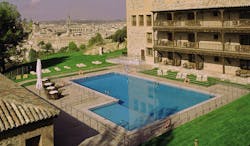
Parador de Toledo is a 4-star historical hotel in a beautiful location overlooking Toledo. The comfort and luxury of this hotel and its delicious local cuisine is ideal after a day's exploration of the historic city.
Standard double room
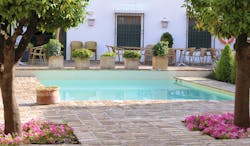
Hotel Puerta de la Luna is a 4-star boutique hotel in an excellent central location. Delicious dining facilities, comfortable accommodation and tranquil terraces afford guests a relaxing haven after exploring the town of Baeza.
Standard double room
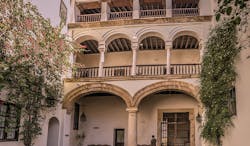
Hotel Las Casas de la Juderia de Córdoba is a 4-star boutique hotel in the old Jewish quarter. Traditional architecture and decor make this a rustic yet cosy hotel in the centre the city.
Standard double room
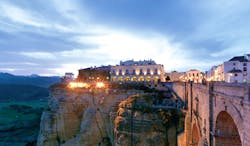
Parador de Ronda is a comfortable 4-star hotel in an excellent central location for exploring the historic town of Ronda. Stunning views, serene gardens and delicious local cuisine and luxurious accommodation afford guests a truly relaxing and restorative retreat.
Standard double room
It has been a lovely holiday & once again, you did not disappoint. Thank you again for everything. We look forward to contacting you again for our next adventure.Mrs H, July 2025
Holiday price guide Prices from £1,820 per person based on two people sharing a double or twin room.
Holiday Code SNFD06
Call us on 01392 441245
Luxury fly-drive touring holiday from Madrid to Toledo and Andalusia staying in Baeza, Cordoba and Ronda
About Andalusia
An Expressions tailor-made holiday to Andalusia offers the chance to explore a holiday destination famed for its indulgent climate and coastal appeal. The region cannot deny its fair share of sun, sea and sand, but what is often neglected to mention is the region's immense variety. Comprising of eight unique provinces, Andalusia spans west to east from the wetlands and the Atlantic Ocean to the deserts and the popular Costa del Sol on the Mediterranean Sea. Poised at the southern-most tip of the Iberian Peninsula, Andalusia acts as a gateway between the European and African continents, harbouring a myriad of influences that speak of the layers of civilisation that have roamed and inhabited the land. From the vibrant cities to the tiny white-washed villages, from vast sierras to the extensive coastline, Andalusia is a region of contrasts which promises an authentic luxury holiday.
Highlights of Andalusia
With 800km of coastline, there are plenty of beaches to choose from - facing the Atlantic are the long, sandy beaches of the Costa de la Luz, extending south from the Portuguese border to Tarifa; covering the area between Malaga and Gibraltar is the famous Costa del Sol, known for its numerous beach resorts which range from the cheap and cheerful to exclusive luxury; to the south of Granada is the Costa Tropical, a stretch of coast with sandy coves and a pleasant microclimate; and to the east is the more rugged Costa de Almeria. A number of luxury resorts and hotels are located along each of these coastlines. Surrounding Granada is the Sierra Nevada, a mountain range where the Spanish mainland's highest peak can be found and home to white-washed mountain villages. In the far east of Andalusia is the Sierras de Cazorla, Segura y Las Villas Natural Park, the largest protected area in Spain where you can find hiking trails, mountain villages and many wild animals. Further south is The Cabo de Gata Natural Park, a land and sea reserve near Almeria which is home to unspoilt scenery and an abundance of wildlife. In the west of the region is the Doñana National Park, an extensive area in the delta of the Guadalquivir River which includes marshland and sand dunes and is a breeding ground of the endangered Iberian Lynx. Thanks to the region's great variety in landscapes, culture and cuisine, a luxury holiday to Andalusia is sure to be a delightful experience.
Cultural highlights of Andalusia
Many of the Andalusia's cultural highlights can be found in the three Moorish cities of Cordoba, Granada and Seville, all of which are home to a number of excellent luxury hotels. Cordoba, a UNESCO World Heritage Site and former centre of Muslim control during Andalusia's colonisation by the Islamic Empire. At the city's heart is the astounding Mezquita de Cordoba, a mediaeval mosque turned Catholic cathedral with endless Moorish arches, columns and glinting tiles of vibrant hues. Other highlights include the fascinating Jewish quarter and Roman ruins galore. Nearer the coast is Granada, where Islamic rule endured the longest and the magical Alhambra remains as a monument to this legacy. A 9th century palace fortress, it guards over the city from an elevated crag amongst vast, aromatic gardens. To the west, on the peaceful plains of River Guadalquivir, Seville quietly awaits discovery along with its three World Heritage Sites: the Alcazar palace, the gothic Cathedral and the General Archive of the Indies. Other towns and cities of interest in Andalusia include Jerez de la Frontera, where you can visit the sherry bodegas which make the city famous and watch the dressage displays which are held at The Royal Andalusian School of Equestrian Art; Cadiz, the oldest city in Europe which is surrounded almost entirely by water; Ronda, a spectacular city which is split in half by a narrow gorge; Malaga, birthplace of Picasso and home to a Museum which displays a collection of his work; the small town of Baeza, where you can find stunning examples of Renaissance architecture; and Almeria, a coastal city which is dominated by the Alcazaba, the largest Moorish fortress in Spain. During your stay in Andalusia make sure to witness the seductive art of flamenco. Alluring, passionate and cathartic, it's easy to understand how this gypsy tradition has become one of the most familiar emblems of Spanish culture.
Festivals in Andalusia
There are a huge number of local festivals held in villages, towns and cities throughout Andalusia, many of which have a religious significance. 5 January: Three Kings parades, February: Shrove Tuesday Carnivals, February: Seville Tapas Fair, February to March: Jerez Flamenco Festival, March/April: Holy week celebrations, April to October: Seville Bullfighting season, April/May: Seville Spring Fair, April/May: Úbeda Classical Music Festival, Mid May: Jerez Horse Fair, June to July: Granada Music & Dance Festival, June - July: Cordoba Guitar Festival, August: Malaga Summer Fair, September: Ronda bullfighting festival, November: Granada Jazz Festival.
Gastronomy in Andalusia
Cuisine in Andalusia is diverse, varying throughout the region and combining Arabic flavours with more common Mediterranean ingredients such as seafood, olive oil and an abundance of fresh fruit and vegetables. As the birthplace of tapas, Andalusia is an excellent place to try the snacks which are often served free with drinks in Granada. Other Andalusian specialities include Serrano ham from the Sierra Nevada and sherry from Jerez de la Frontera, as well as dishes such as ‘Ajo blanco’ (a white gazpacho), ‘Espetos de sardina’ (roasted sardines), ‘Huevos a la flamenca’ (baked eggs with vegetables) and ‘Fritura de pescado’ (mixed fried fish).
Call us on 01392 441245
Luxury fly-drive touring holiday from Madrid to Toledo and Andalusia staying in Baeza, Cordoba and Ronda
About Heart of Spain
An Expressions tailor-made holiday to the Heart of Spain feature some of the best four and five star hotels in central Spain, featuring vineyard hotels, rural estates and city properties. Located at the geographical heart of Spain is its vibrant capital, Madrid, where days can be filled with art galleries and atmospheric outdoor cafes, and evenings promise an energetic nightlife. Surrounding the city are the dry plains of the country's central plateau which are divided by spectacular mountain ranges and dotted with numerous castles, magnificent cathedrals and ancient Roman ruins. The regions which make up Spain's central plateau have all played a hugely important role in the history of modern Spain, which is evident in the numerous castles which were built to protect towns and villages as the Moors fought the Christians in the 10th and 11th centuries. These are some of the least visited parts of Spain where few tourists venture outside of the main cities, ensuring that visitors will leave feeling like they have discovered something new. At the centre of Spain is Madrid, where atmospheric cobbled streets link bustling squares which are filled with pavement cafes and flea markets, whilst tree-line boulevards are overlooked by neo-classical buildings. Surrounding the city are the dry plains of the country's central plateau which are divided by spectacular mountain ranges and dotted with numerous castles, magnificent cathedrals and ancient Roman ruins. To the north of Madrid is Castilla y León, an elevated region which has played a hugely important role in the history of modern Spain. Rolling countryside is littered with historic cities, isolated villages and mediaeval castles, built by the Christians to defend against the Moorish invaders. Salamanca, Avila, Segovia, León, Valladolid and Burgos are all home to a wealth of art and stunning architecture, including Gothic cathedrals and Roman structures. Away from the cities are natural attractions including mountain ranges and nature reserves, with wheat fields and vineyards covering the high plateaus. To the south and east of Madrid is Castilla-La Mancha, an expansive region with dry plains stretching towards mountains in the distance. The predominantly flat scenery is made up of olive groves, wheat fields, extensive vineyards, hilltop castles and the iconic windmills described by Cervantes. Head to the historic city of Toledo, where Christian, Jewish and Arab cultures blend to create a popular tourist destination, or to Cuenca, a dramatic town where houses seemingly dangle over a plunging gorge. Further west towards the border with Portugal is Extremadura, a region with green pastures and rolling hills, forests and fertile river valleys, as well as charming towns boasting stunning examples of Roman architecture. Elaborate palaces and manor houses are found in clusters throughout the region, built by conquistadors with gold from the New World.
Highlights of the Heart of Spain
The three world-class art galleries which make up Madrid's Golden Triangle of Art, home to works by Pablo Picasso, Salvador Dalí and Francisco de Goya. The historical sights of Old Madrid, including the lavish Royal Palace, the grand Plaza Mayor and the city's spiritual centre, Puerta del Sol. Parque del Retiro, a popular spot for relaxation in the centre of Madrid with a boating lake. El Escorial, a large royal residence just outside Madrid which also functions as a monastery and is where many Spanish monarchs are buried. The Gothic cathedrals of León, Burgos and Toledo which feature stunning stained glass, mediaeval art and elaborate sculptures. The numerous castles which are scattered across the region including the Gothic-style Belmonte Castle, the Mudejár Coca Castle and the Moorish Alcazaba of Badajoz. The university city of Alcalá de Henares, birthplace of Cervantes, the 16th century author who wrote about the adventures of Don Quixote. The walled city of Ávila. The university city of Salamanca. Segovia, with its Roman Aqueduct and distinctive castle. Cuenca, a picturesque old town with houses which appear to hang over a gorge. The iconic windmills which sit on the plains near Consuegra. Roman ruins in Mérida. Elaborate palaces and manor houses in Trujillo and Cáceres. The wine-producing regions throughout central Spain including Ribera del Duero, La Mancha and Valdepeñas where visitors can visit vineyards and enjoy wine tastings. Mountain ranges which divide the central plateau, with many opportunities for walking and rock climbing.
Festivals in the Heart of Spain
February: Caja Madrid Flamenco Festival, February to March: Madrid Carnival, February to March: Madrid Contemporary Art Fair, March/April: Holy week celebrations, May: San Isidro bullfighting festival (Madrid), May/June: Toledo Corpus Christi processions (Toledo), July to August: Madrid summer arts festival, October: Saffron Rose Festival (Consuegra), October: Cervantes Week (Alcala de Henares), October to November: Madrid Autumn Festival
Gastronomy in the Heart of Spain
As expected, Madrid is home to some excellent restaurants serving a great range of cuisine from throughout Spain and around the world. Roasted meat and game as well as a variety of broths and stews are common features on menus throughout central Spain, where traditional cooking is simple and hearty. Cuisine varies slightly between the regions, with more paprika and saffron being used in the south. Various pulses are grown on the plains of Castilla y León, whilst Manchego cheese produced in La Mancha and high quality Ibérico ham is produced in Extremadura. There are a number of wine regions which produce high-quality red and white wines. Local dishes include ‘Pollo a lo Padre Pero’ (chicken with a spicy sauce), ‘El frite’ (fried lamb), ‘Sopa de ajo’ (garlic soup), ‘Pisto manchego’ (similar to ratatouille), ‘Yemas’ (a rich dessert made with egg yolks).
Climate in the Heart of Spain
The climate of central Spain is generally quite extreme, with extremely hot summers and bitterly cold yet dry winters. Rainfall is generally quite low thanks to the mountains which surround the region. Madrid can be almost unbearable in the summer months as temperatures reach 40 degrees, whilst during the temperatures regularly drop below freezing. Spring and autumn are the best times to visit as temperatures are warm and pleasant, although there is increased rainfall.
Call us on 01392 441245
Luxury fly-drive touring holiday from Madrid to Toledo and Andalusia staying in Baeza, Cordoba and Ronda
About Madrid
An Expressions tailor-made holiday to Madrid is a chance to explore this lively and passionate capital city with a laid-back lifestyle. Atmospheric cobbled streets link bustling squares which are filled with pavement cafes, whilst tree-lined boulevards are overlooked by neo-classical buildings. Our luxury holidays to Madrid feature some of the best four- and five-star hotels in the city, including elegant hotels and more boutique properties. Visitors to Madrid will find plenty to fill their days. Art and culture play an important role, primarily thanks to the three world-class art museums which make up Madrid’s Golden Triangle of Art, home to works by Pablo Picasso, Salvador Dalí and Francisco de Goya. Illustrating the city’s rich history are the sights of Old Madrid, including the lavish Royal Palace, the grand Plaza Mayor, and the city’s spiritual centre – Puerta del Sol. There are plenty of designer shops to browse throughout the city, as well as small boutiques and flea markets which visitors might stumble across. It is after dark that Madrid really comes alive as the streets, parks and open-air cafes fill with people of all ages and the bars and clubs remain open until dawn. What better way to recover from a late night than to while away a morning in the Parque del Retiro, strolling through the beautiful gardens and perhaps hiring a rowing boat on the park’s tranquil lake. For those who wish to escape the energetic city, a number of towns are located nearby which make for an interesting day trip.
Highlights of Madrid
Numerous squares including the historic Plaza Mayor, the setting of bullfights and executions during the Spanish Inquisition. The Royal Palace, a lavish building which was constructed in the 1700s and is still used today for state occasions. The Prado Museum, one of the largest art galleries in the world which contains an impressive selection of Spanish paintings including works by Goya and El Greco. Reina Sofia Museum, displaying modern works including Picasso’s ‘Guernica’. Thyssen-Bornemisza Museum, based on a private art collection which illustrates the history of western art and includes pieces by Goya, Degas and Renoir. Retiro Park formerly used by the royal family and now a popular spot for relaxation. The Teatro Real, an important opera house with performances of opera and dance. Almudena Cathedral. Gran Vía, a famous street which is lined by theatres and shops. Debod Temple, an ancient Egyptian temple which was rebuilt in Madrid in the 1960s. The Santiago Bernabéu Football stadium, home to Real Madrid. El Rastro Market, an open-air flea market which is held on Sundays. Ventas Bullring where bullfights take place every week during the bullfighting season.


